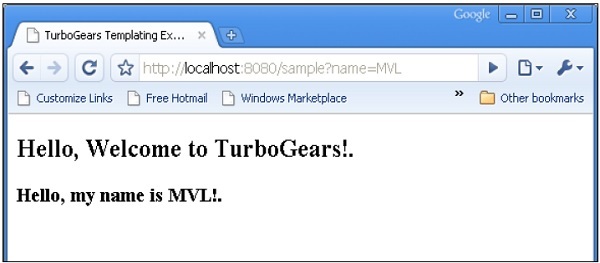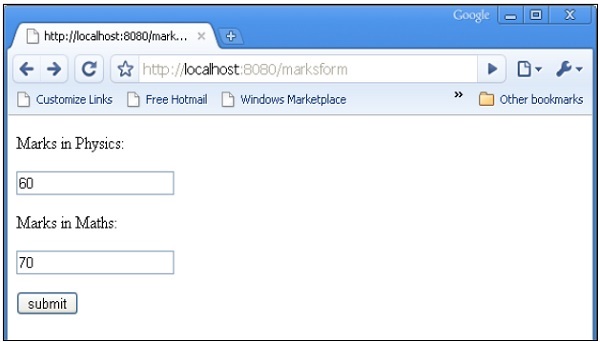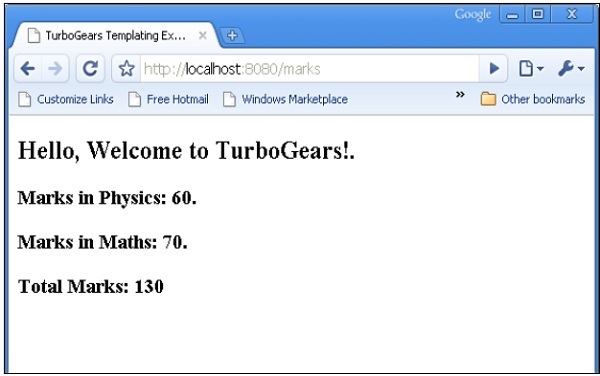TurboGears-HTTPメソッド
Httpプロトコルは、ワールドワイドウェブでのデータ通信の基盤です。このプロトコルでは、指定されたURLからデータを取得するさまざまな方法が定義されています。次の表は、さまざまなhttpメソッドをまとめたものです。
| シニア番号 | HTTPメソッドと説明 |
|---|---|
| 1 | GET 暗号化されていない形式でデータをサーバーに送信します。最も一般的な方法。 |
| 2 | HEAD GETと同じですが、応答本文はありません |
| 3 | POST HTMLフォームデータをサーバーに送信するために使用されます。POSTメソッドで受信したデータはサーバーにキャッシュされません。 |
| 4 | PUT ターゲットリソースの現在のすべての表現をアップロードされたコンテンツに置き換えます。 |
| 5 | DELETE URLで指定されたターゲットリソースの現在の表現をすべて削除します |
HTMLフォームの作成
HTMLフォームを作成し、フォームデータをURLに送信しましょう。次のスクリプトをlogin.htmlとして保存します
<html>
<body>
<form action = "http://localhost:8080/login" method = "get">
<p>Enter Name:</p>
<p><input type = "text" name = "nm" /></p>
<p><input type = "submit" value = "submit" /></p>
</form>
</body>
</html>このフォームに入力されたデータは、 ‘/login’ URL。次に、コントローラー関数を作成しますloginpage() 上記のhtmlページを公開します。
@expose("hello.templates.login")
def loginpage(self):
return {}フォームデータを受信するには、 login()コントローラ。パラメータとしてフォーム属性があります。ここに‘nm’ ログインフォームのテキスト入力フィールドの名前であり、login()関数のパラメータとして使用されます。
@expose("hello.templates.sample")
def login(self, nm):
name = nm
return {'person':name}ご覧のとおり、ログインフォームから受信したデータはsample.htmlテンプレート(先ほど使用)に送信されています。それはによって解析されますGenshi template engine 次の出力を生成するには-

POSTメソッド
HTMLフォームがPOSTメソッドを使用してアクション属性のURLにデータをディスパッチする場合、フォームデータはURLで公開されません。エンコードされたデータは、dictコントローラ関数による引数。**kw 以下の引数は、データを保持する辞書オブジェクトです。
HTMLフォームには、2つの入力テキストフィールドが含まれています。
<html>
<body>
<form action = "http://localhost:8080/marks" method = "post">
<p>Marks in Physics:</p>
<p><input type = "text" name = "phy" /></p>
<p>Marks in Maths:</p>
<p><input type = "text" name = "maths" /></p>
<p><input type = "submit" value = "submit" /></p>
</form>
</body>
</html>ザ・ marks() コントローラはフォームデータを受信し、に送信します sample.htmlテンプレート。のコードroot.py 次のとおりです-
from hello.lib.base import BaseController
from tg import expose, request
class RootController(BaseController):
@expose("hello.templates.marks")
def marksform(self):
return {}
@expose("hello.templates.sample")
def marks(self, **kw):
phy = kw['phy']
maths = kw['maths']
ttl = int(phy)+int(maths)
mydata = {'phy':phy, 'maths':maths, 'total':ttl}
return mydata最後に、sample.htmlテンプレートは次のとおりです-
<html>
<head>
<title>TurboGears Templating Example</title>
</head>
<body>
<h2>Hello, Welcome to TurboGears!.</h2>
<h3>Marks in Physics: ${phy}.</h3>
<h3>Marks in Maths: ${maths}.</h3>
<h3>Total Marks: ${total}</h3>
</body>
</html>サーバーを起動します(まだ実行されていない場合)
Gearbox server –reload –debug入る http://localhost::8080/marksform ブラウザで

ザ・ sample.html 次の出力をレンダリングします-
